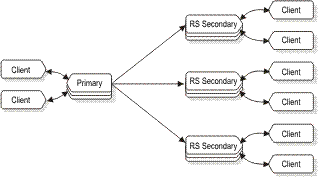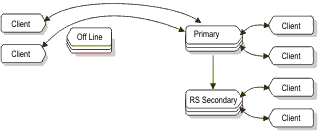Remote standalone secondary configuration examples
The following figure illustrates an example of a configuration consisting of multiple RS secondary servers. This configuration would be useful in a situation where the primary server is located a long distance from the RS secondary servers or if the network speed between the primary server and the RS secondary server is slow or erratic. Because RS secondary servers use fully duplexed communication protocols, and do not require synchronous checkpoints processing, the primary-server's performance is usually unaffected.

The next illustration shows an example of a configuration of an RS secondary server along with an HDR secondary server. In this example, the HDR secondary provides high availability while the RS secondary provides additional disaster recovery if both the primary and HDR secondary servers are lost. The RS secondary server can be geographically remote from the primary and HDR secondary servers so that a regional disruption such as an earthquake or flood would not affect the RS secondary server.


